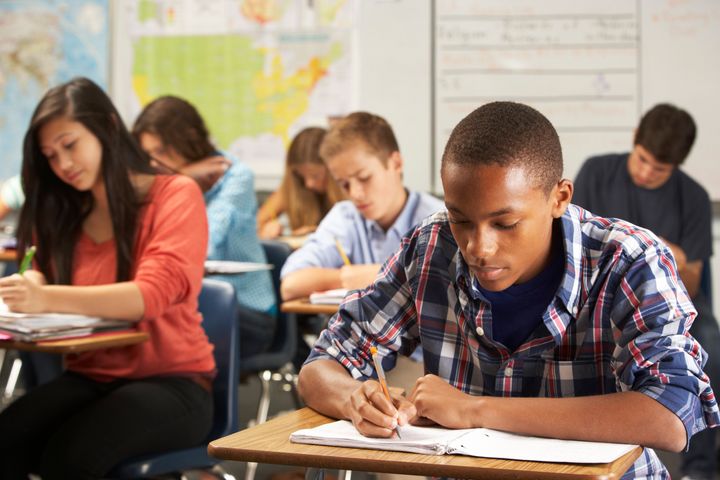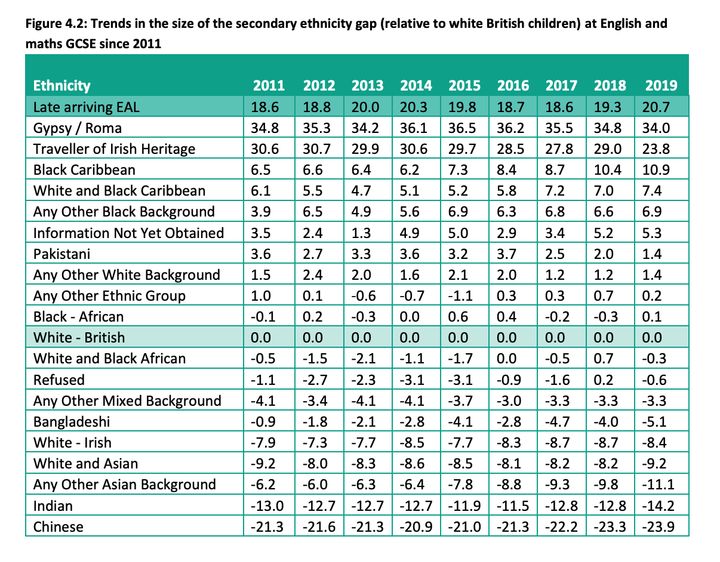
Black Caribbean pupils have fallen dramatically behind their white counterparts at GCSE level in the past five years in the wake of school budget and welfare cuts, a new report has found.
The Education Policy Institute (EPI) found that Black children suffered disproportionately as progress on narrowing the “attainment gap” between richer and poorer pupils stalled for the first time in a decade.
The think tank’s annual report said that disadvantaged children of all races were being penalised by inequality even before the impact of Covid-19 this year, when school closures were widely believed to have hit the less well off hardest.
Researchers found that disadvantaged pupils in England are 18.1 months of learning behind their peers by the time they finish their GCSEs – the same gap as five years ago and the first time in years that the gap has not narrowed.
It found that the rich-poor attainment gap in primary school – at 9.3 months – was actually now widening for the first time since 2007, when Tony Blair was in power.
And progress in narrowing the gap for pupils with disabilities, special needs, in care or receiving help from social services has also stalled in the past five years.
EPI chief, former schools minister David Laws, told HuffPost UK that the study suggested “an iron link between poverty and educational outcomes”.
He warned that Boris Johnson’s claim to be “levelling up” the country could only succeed with a dramatic change of course.
Among the most stark findings was a worsening of performance for Black Caribbean pupils at English and Maths GCSE.
In 2014, the group was already 6.2 months of learning behind their white counterparts. But the figure soared to 10.9 months in 2019.
By contrast, Bangladeshi children have dramatically improved their GCSE performance. In 2011 they were narrowly ahead of white pupils by nearly a month, but in 2019 they were 5.1 months ahead.
Chinese pupils are nearly two years ahead of white pupils in attainment, while Indian pupils are a year ahead.
Roma and Irish traveller children suffered the biggest gap, with upto three years behind at GCSE, but unlike Black pupils their performance has improved since 2011.

Laws said poverty – and possibly welfare cuts – were most likely to be the cause. “It would be difficult to understand why ethnic prejudice or a change in the quality of schools or anything like that would have affected this group so rapidly,” he said.
“We can see that nothing much was happening between Black Caribbean and White British [gaps] until 2015 and over the last four years they have basically fallen behind by a month of learning every year. This is a really short period of time.
“To explain a change of that magnitude over a short period of years it’s difficult to think of anything other than relative economic circumstances that would explain it.
“It could be that versus a white British population, their economic circumstances have fallen behind a lot, maybe more of them are dependent upon the welfare system and they’ve been suffering from the welfare expenditure [cuts].”
EPI will conduct a separate review into the racial disparities. “While it is likely that poverty is contributing to some of these trends, there is also a need to understand the extent to which other societal and educational factors are creating and worsening inequalities amongst these groups of pupils,” it said.
Disadvantage gaps are particularly acute in the North, West Midlands and parts of the South.
In some areas, poorer pupils are over two full years of education behind their peers by the time they take their GCSEs, including in Blackpool (26.3 months), Knowsley (24.7 months) and Plymouth (24.5 months).
In contrast, there are very low GCSE disadvantage gaps concentrated in London, where teachers tend to be paid more, funding per pupil has been higher and where the “London challenge” under Labour shared best practice.
Tower Hamlets and Newham both low gaps, with 5.6 months each. Other relative successes were Ealing (4.6 months), Redbridge (2.7 months) and Westminster (0.5 months).
Researchers also found that children suffering from long term poverty – defined as those on free school meals for over 80% of their time at school – have twice as worse a learning gap as others who spend a short time on the breadline.
Those in “persistent” poverty have a learning gap of 22.7 months, compared to 11.3 months for poor pupils who are on free school meals for less than 20% of their time at school.
Significantly, the proportion of pupils with a high persistence of poverty is on the rise. Since 2017, the proportion of pupils in this group has risen from 34.8% to 36.7%, a rise the study says “appears to be an important contributor to the lack of progress with the gap overall”.
The report concludes: “This year’s annual report provides concerning evidence that progress in narrowing educational inequalities has ground to halt.
“While educational standards and overall attainment has been maintained since the previous year (and even increased slightly at secondary school), the gap between disadvantaged pupils and their non-disadvantaged peers has stopped closing.
“This was the worrying position from which the school system entered the many challenges of the pandemic and lockdown in 2020, which are widely expected to worsen disadvantage gaps.
“The gap has now begun to widen across all three phases of education that we consider in this report – the early years, primary school and secondary school.”
Laws told HuffPost UK that the findings were the “complete opposite” of the vision that Johnson used to win his big majority in the general election last year.
“This could be the first government for 20 years that doesn’t level up but ends up with less social mobility and less opportunity.”
He said that greater early years funding would make a big difference, as well as much greater catch-up funding for poorer areas. Under Johnson’s plans, Tory areas which traditionally got less cash will get more money as part of his “levelling up” plan.
“While we don’t want poverty to be almost an excuse for poor educational performance, what we can see is there is an iron link between poverty and educational outcomes at a national level,” Laws said.
“Reducing the gap at a time when there is rising child poverty would be very challenging and for Gavin Williamson to deliver more social mobility and a smaller gap, he would need education policy and wider social policy to be working in tandem. Which means not increasing levels of poverty through further real cuts in welfare expenditure.”
Professor Becky Francis, CEO of the Education Endowment Foundation, said: “Today’s EPI report again shows that the attainment gap between disadvantaged pupils and their more affluent peers continues to blight our education system. As our research shows, this gap is likely to have widened considerably as a result of school closures.”
A spokesperson for the Department of Education said: “Our £1 billion Covid catch up package will tackle the impact of lost teaching time, including a £650 million catch up premium to help schools support all pupils and the £350 million National Tutoring Programme for disadvantaged students.
“This includes up to £9 million available for the Nuffield Early Language intervention programme to support those who have missed out on early education at an essential time for their development.”
The department added that it has committed £100 million to support remote education for disadvantaged and vulnerable pupils facing key points in their education.
By the end of June over 202,000 laptops and tablets and over 47,000 4G wireless routers had been delivered or dispatched to academy trusts and local authorities.
